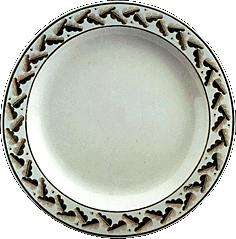 |
Soup Tureen with Stand, circa 1800 Maker: Wedgwood Staffordshire, England Canadian Museum of Civilization Cat. no. A-3479-1a,b,c Slide no. 17947 |
|
|
|
||
CREAMWAREAt the end of the eighteenth century a French scientist, Barthélémy Faujas de Saint-Fond, noted that English earthenware for the table was in use throughout Europe, the East Indies, the West Indies and the continent of America. With this earthenware, cream in colour, British potters were making their first major impact on world markets.The ware owed its success to the first Josiah Wedgwood. In the second half of the century, he had taken an existing Staffordshire body and had so refined and perfected it that it became almost a new invention. He called it "Queen's ware" after Queen Charlotte gave him orders for it in 1765. Other British potters copied this improved body and adopted Wedgwood's name for it. Canadian importers used the terms "queensware" and "cream-coloured earthenware" interchangeably, without regard to maker. Light in weight and brilliantly glazed, this was the ware most often found on Canadian tables when the nineteenth century dawned. The decoration, if any, was usually hand-painted.
Much that was imported was unmarked as to maker. It came from Scottish as well as English potters. Records exist, however, to show that Wedgwood was owned by such people as Sir James Monk, attorney-general of Quebec, and Sir Robert Shore Milnes, lieutenant-governor of the province. Early in the nineteenth century, a Quebec merchant was advertising "Wedgwood's finest cream-coloured Earthen Ware, in crates, each containing a complete dinner-service." Until the second half of the century, however, it was only occasionally that an importer mentioned any potter's name in advertisements. Another known supplier of creamware to Canada was Liverpool's Herculaneum Pottery, and one of the rarities in the Museum's collection is a small Herculaneum plate with a lustre rim. It is a rarity because lustre was not often used at this pottery. Also, the overglaze printed decoration — of a sailor taking soundings — is usually found on unmarked specimens.
It was Herculaneum's practice to give ships' captains samples of its products to show to prospective customers abroad. In 1798 (two years after the founding of the pottery), the captain of the sailing ship Ephron arrived in the port of Quebec with a selection of Herculaneum earthenware. He showed it to George Pozer, a prominent merchant. Pozer liked what he saw and sent off an order for creamware. He also became an agent for the Liverpool pottery. Other agents, possibly recruited in the same way, were appointed in Prince Edward Island, Nova Scotia and Newfoundland. As the nineteenth century advanced, earthenware that was cream in colour ceased to be the ware most commonly found on Canadian tables. It was superseded by newer wares, but it never entirely disappeared. If hand-painted, the decoration was now frequently applied within printed outlines. When the "Japanese mania" swept over the Western world, reaching its height of popularity in the last quarter of the century, creamware decoration often reflected the new craze.
The asymmetrical arrangement of the decoration on a pair of Minton creamware plates in the Museum's collection reflects the Japanese influence. A small ornamental teapot borrowed its shape from Japanese pewter and lacquer wares. Its handle simulates bamboo; there is also bamboo decoration on its silver lid. |
||||||||||||||||||


